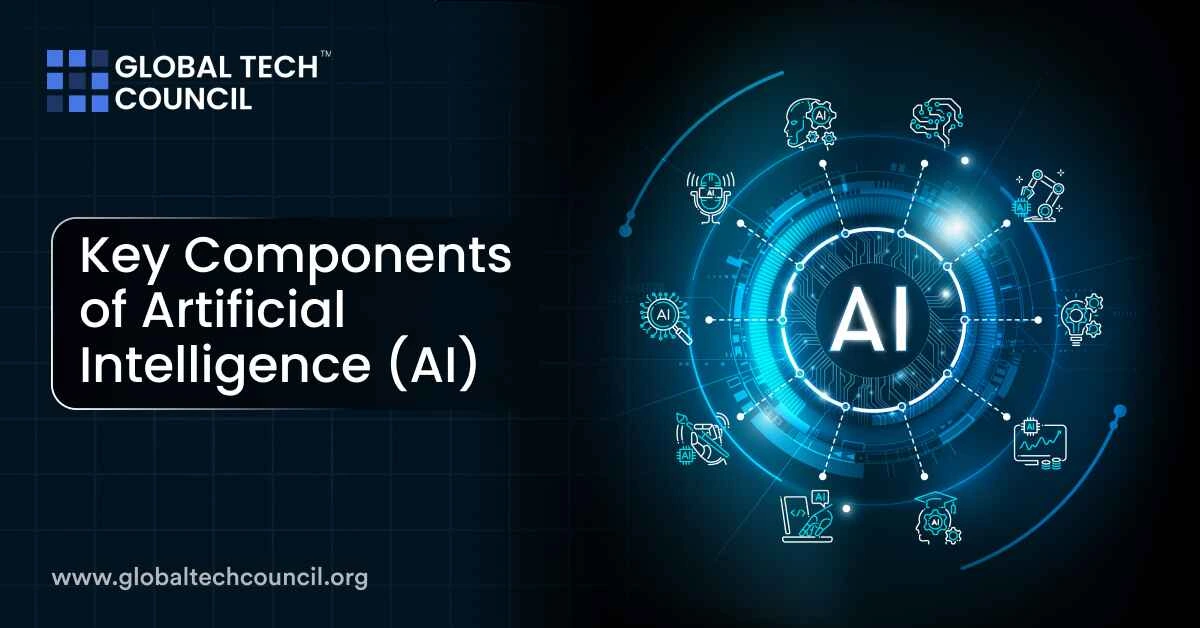Artificial intelligence (AI) consists of multiple important elements that help machines imitate human-like mental processes. These components allow AI to tackle problems, make choices, understand speech, and adjust to new data. Let’s go over the five key elements of AI: learning, reasoning, problem-solving, perception, and language processing.
1. Learning
Learning is the core of any AI system. It refers to AI’s capability to get better over time by collecting experience from data. Unlike traditional programming, which requires each task to be specifically coded, AI uses different learning methods to adjust and become smarter. Here are the three main types of learning used in AI:
- Supervised learning involves training the AI with labeled data, so it knows what to look for. This allows the system to make predictions or sort new data based on examples provided. For instance, an AI trained to recognize handwritten numbers learns by examining thousands of labeled images.
- Unsupervised learning doesn’t rely on labeled information. Instead, it identifies patterns and relationships within the data on its own. This method is commonly used in customer segmentation, where AI identifies customer groups with similar buying habits.
- Reinforcement learning mirrors how people learn through trial and error. The AI interacts with its surroundings, getting feedback like rewards or penalties, and uses this to improve its long-term performance. A clear example of reinforcement learning can be found in gaming or robotics, where AI agents develop strategies through repeated attempts.
Example: Voice assistants like Siri or Alexa use machine learning to better understand and respond to users. Over time, they improve by recognizing speech patterns and fine-tuning their answers.
2. Reasoning
Reasoning enables AI to make choices or reach conclusions based on available facts. This involves using logic or probability models to replicate human thinking. There are two types of reasoning:
- Deductive reasoning takes a general rule and applies it to specific situations. For example, in legal systems, AI can analyze many cases to predict the results of new cases.
- Inductive reasoning generalizes from specific examples. This is especially useful in healthcare, where AI can identify health patterns from specific patient data to help doctors make decisions.
Example: Writing tools like Grammarly use reasoning to offer corrections. It understands when a comma should be added or when a sentence needs improvement, helping users write better without needing to give direct commands.
3. Problem-Solving
AI is great at problem-solving, which involves finding answers to difficult challenges. This part allows machines to break complex tasks into simpler steps. AI problem-solving isn’t limited to routine issues; it can also tackle unique, complicated situations. For example, in chess, AI analyzes possible moves and predicts outcomes based on its knowledge of the game’s rules.
Example: In a chess match, AI can scan millions of potential moves to pick the best one using its knowledge of the game’s state and strategies. Similarly, in medical diagnosis, AI reviews symptoms and data to suggest treatments.
4. Perception
Perception involves AI’s ability to handle and make sense of sensory data from its environment. This could include recognizing images, sounds, or other forms of information. AI systems frequently use perception when they need to interact with the physical world. For example, self-driving cars use cameras, radar, and lidar to “see” the road, spot obstacles, and make driving decisions.
A common real-world example of AI perception is facial recognition, where AI looks at visual data to detect and recognize faces. Likewise, AI-powered security systems can detect suspicious activity and alert authorities to potential risks.
Perception plays a significant role in how AI interacts with the world and is widely used in fields like healthcare (for example, AI-assisted medical imaging diagnostics) and retail (for example, checkout-free shopping).
AI systems often rely on sensors like cameras and microphones to understand their surroundings. Examples of perception tasks include things like recognizing images, detecting objects, and processing speech.
Example: A smart home system uses perception to detect movements indoors and outside. It processes data from sensors to make decisions in real-time.
5. Language Understanding
Natural Language Processing (NLP) is a field within AI that allows machines to grasp, interpret, and react to human language. It’s a widely applied feature in today’s consumer technologies. NLP is commonly used in virtual assistants like Siri and Alexa, which process spoken commands and respond appropriately.
NLP also plays a big role in sentiment analysis, which helps businesses examine customer feedback by figuring out the emotions or attitudes behind written text, such as social media posts or product reviews.
Example: Translation services like Google Translate process text or speech in one language and convert it into another, helping bridge communication gaps across different languages.
Conclusion
AI’s five key parts—learning, reasoning, problem-solving, perception, and language processing—are what enable these systems to handle tasks that once required human intelligence. Each component is crucial in building AI’s abilities, from processing data to interacting with the world around it. As AI keeps advancing, its ability to solve complicated issues and boost efficiency across various sectors will expand even further.
